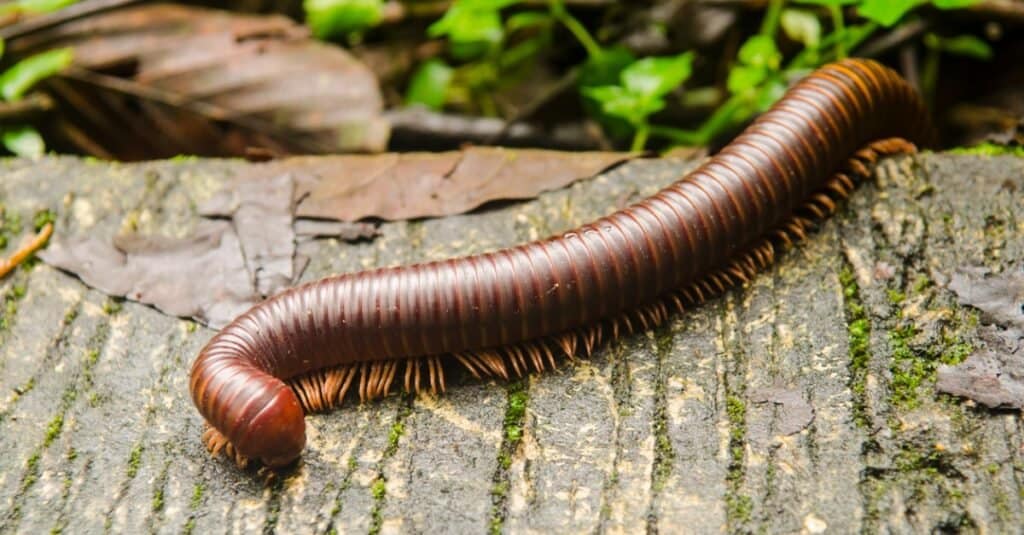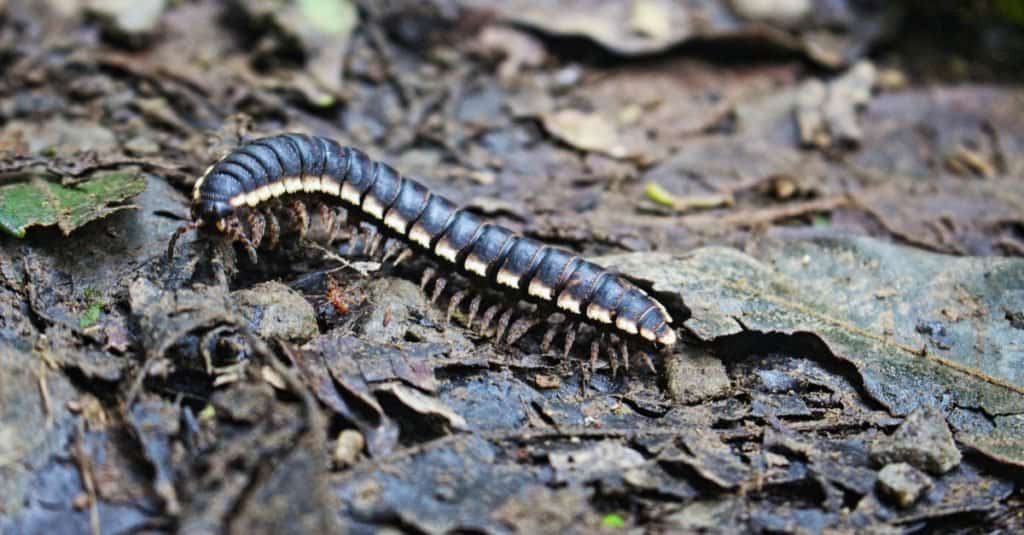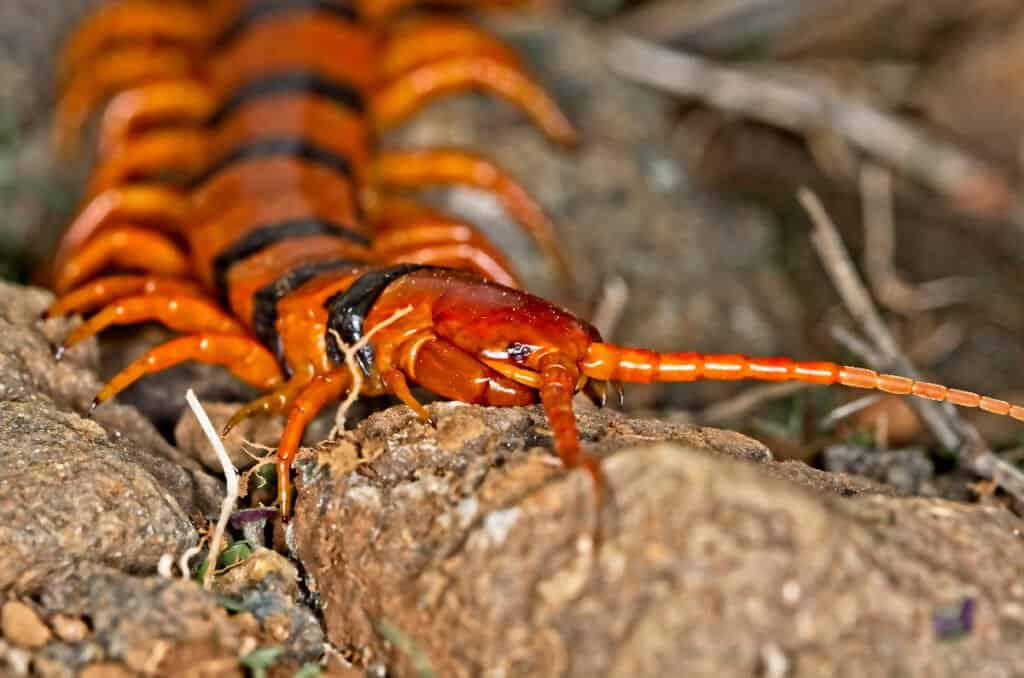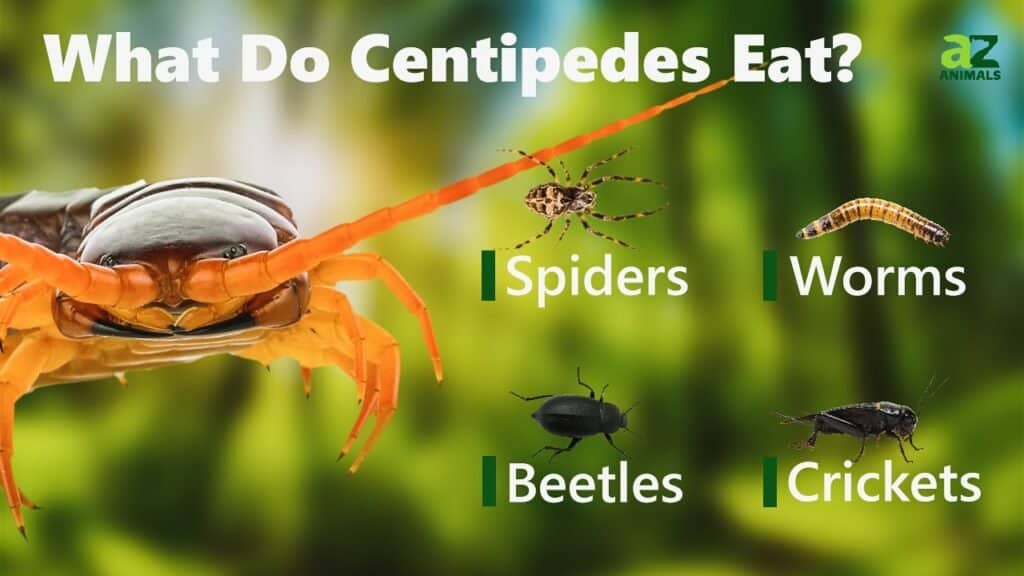Centipede
There are about 3,000 documented species!
Advertisement
Centipede Scientific Classification
Read our Complete Guide to Classification of Animals.
Centipede Conservation Status
Centipede Facts
- Main Prey
- Insects, Spiders, Worms
- Fun Fact
- There are about 3,000 documented species!
- Habitat
- Decomposing matter on forest floor
- Diet
- Carnivore
- Average Litter Size
- 60
- Favorite Food
- Insects
- Common Name
- Centipede
- Number Of Species
- 3000
- Location
- Worldwide
- Slogan
- There are about 3,000 documented species!
View all of the Centipede images!

Centipedes are predatory arthropods with flat, segmented bodies.
These multi-legged creatures can range in size from two inches to over a foot. Because they lack a hard outer skeleton, centipedes must spend most of their time near water.
This is why these animals prefer a damp habitat. You can find them hiding under mulch or in bathroom and kitchen drains. It’s also why they are more active at night.
6 Incredible Centipede Facts!

Babies are born with four sets of legs. As they mature, they develop more legs.
©skifbook/Shutterstock.com
- Even though their name means “100 legs,” no centipede has 100 legs. That’s because everyone has an odd number of pairs of legs.
- Babies are born with four sets of legs. As they mature, they develop more legs.
- A female can have 150 babies in her lifetime.
- The one-inch house centipede of Europe and North America is the only one common in homes.
- The biggest centipede species in the world is Scolopendra gigantea, a tropical bug that can grow over a foot long!
- Scolopendra galapagoensis, also known as Darwin’s Goliath Centipede, is a large, poisonous species that only live on the island of Galapagos.
Species, Type, and Scientific Name

A centipede (Scolopendra sp.) sleeping on a mossy tree in a tropical rainforest.
©frank60/Shutterstock.com
These animals belong to the phylum Arthropoda and class Chilopoda. They are part of the phylum Arthropoda and subphylum Atelocerata.
Their scientific name comes from the Greek words cheilos, meaning lip, and pod meaning foot.
Millipedes and centipedes belong to the same order but are not in the same class. Millipedes belong to the class Diplopoda.
There are approximately 3000 species. They range in size and color from the huge Scolopendra gigantea to the one-inch house centipede found in most homes.
Tropical species are brightly colored and may have multicolored red, yellow, blue, and green segments. Smaller centipedes who live in temperate climates are more likely to be brown or gray in color.
All of them are instantly recognizable by their segmented body and many pairs of legs. The number of legs can vary from 15 to 170 pairs.
Most of these animals belong to the order on the following list:
- Scutigeromorpha
- Lithobiomorpha
- Craterostigmomorpha
- Scolopendromorpha
- Geophilomorpha
- House Centipede
- Scolopendridae
- Scolopendra
- Scolopendromor
- Geophilomorpha
- Stone centipedes
Evolution and Origins

Millipedes are different from centipedes bc they feed on dead matter rather than insects.
©iStock.com/greenleaf123
Centipedes belong to the class Chilopoda and have a rich evolutionary history that dates back to the Late Silurian period, over 430 million years ago. Fossil evidence indicates that the earliest centipedes were similar in size and shape to modern species, with long, segmented bodies and numerous legs.
Over the course of their evolution, centipedes have diversified into several different groups, each adapted to a specific habitat and way of life. Some species have become adapted to living in forests, while others have evolved to live in caves, deserts, or grasslands.
Despite their long history, centipedes have undergone relatively little change over time. This is due in part to the fact that they are well-adapted to their environments and have been successful in colonizing a variety of habitats.
Appearance

House centipedes range in size from one to six inches. They move extremely fast on their long legs, but you can easily identify them when you see them.
©Christian Giaffrey/Shutterstock.com
House centipedes range in size from one to six inches. They move extremely fast on their long legs, but you can easily identify them when you see them.
How do you tell millipedes and centipedes apart? Millipedes have a lot of legs, but their legs are short and stubby. They move slowly and carefully. Centipedes, on the other hand, have long legs that let them move quickly.
Another difference is that millipedes don’t bite, but centipedes do. However, the bites of all kinds of centipedes, including house centipedes, although venomous are generally harmless to humans.
Tropical species are large and colorful. The largest known species is the Scolopendra gigantea, which is also known as the Peruvian giant centipede. This tropical beast is brightly colored and can reach more than a foot in length. You are not likely to see tropical centipedes inside homes.
Learn about the house centipede here.
Habitat

The species
Scutigera Coleoptratais also known as the house centipede.
©ananth-tp/Shutterstock.com
They live in both temperate and tropical regions, where you are likely to find them living under fallen logs, bark, mulch, and stones.
Most of them are active on the ground, but others can burrow into soft soil. Tropical species usually live in trees and inside caves.
The species Scutigera Coleoptrata is also known as the house centipede. You often find house centipedes indoors, where they like to live in bathrooms because of the damp conditions.
Diet

These animals are predatory and carnivorous. Their favorite prey is small insects, including beetles, termites, beetle larvae, and earthworms.
Large tropical centipedes feed on lizards, birds, bats, frogs, snakes, and mice.
These animals are almost blind, and burrowing centipedes have no eyes. Despite this inability to see, they are excellent hunters.
They have long antennae that can sense the availability of food. When they find prey, they use their front legs to grab the prey. Their front legs have sharp pincers that contain venom. Their venom can paralyze the prey or kill it instantly.
Burrowing centipedes use their pincers to dig into the earth. They feed on earthworms, snails, and nematodes.
For a complete analysis of their diet, give our ‘What Do Centipedes Eat’ page a read!”
View all 235 animals that start with CCentipede FAQs (Frequently Asked Questions)
Are Centipedes herbivores, carnivores, or omnivores?
Centipedes are Carnivores, meaning they eat other animals.
What Kingdom do Centipedes belong to?
Centipedes belong to the Kingdom Animalia.
What phylum do Centipedes belong to?
Centipedes belong to the phylum Arthropoda.
What order do Centipedes belong to?
Centipedes belong to the order Chilopoda.
What type of covering do Centipedes have?
Centipedes are covered in Shells.
Where do Centipedes live?
Centipedes are found worldwide.
In what type of habitat do Centipedes live?
Centipedes live in decomposing matter on forest floors.
What is the main prey for Centipedes?
Centipedes prey on insects, spiders, and worms.
What are some predators of Centipedes?
Predators of Centipedes include birds, toads, and small mammals.
How many babies do Centipedes have?
The average number of babies a Centipede has is 60.
What is the scientific name for the Centipede?
The scientific name for the Centipede is Chilopoda.
How many species of Centipede are there?
There are 8,000 species of Centipede.
How many legs does a centipede have?
Every centipede has a different number of legs. It is always an odd number of pairs.
Are house centipedes dangerous?
House centipedes can’t hurt humans. In fact, if you see a lot of them in your home, it’s a sign that your house has insects that centipedes like to eat.
House centipedes aren’t looking for you. They are looking for crickets, roaches, flies, termites, and other insects in your home.
Are tropical centipedes dangerous to humans?
Yes. Their venom won’t kill you, but it will cause pain. The bites from Giant Scolopendridae, a foot-long centipede from Australia, can cause burning pain for several days.
The Scolopendra Cataracta, an equally large centipede that lives in Southeast Asia, also has a painful bite. You should avoid any large, colorful centipede that lives in a tropical or jungle climate.
How Do You Get Rid of Centipedes In Your House?
The best way to keep them out is to seal cracks in the walls and pavement. Keep the drains in your kitchen and bathroom clean and cover grease drains. Keep your garden clear of damp piles of brush and logs, and avoid planting climbing plants near your home.
What are the main differences between a caterpillar and a centipede?
The most noticeable differences between a caterpillar vs centipede include their morphology, legs, and exoskeleton. Caterpillars have round bodies with indistinct heads, small antennae, and horns in some species. On the other hand, centipedes have flat bodies, a distinct head, and prominent antennae that stick out very far from their body. Besides, caterpillars have fewer legs than centipedes. While caterpillars are herbivores, centipedes are carnivores. Caterpillars are classified as insects, (although they are the larvae form of butterflies) but centipedes are classified as anthropods. And lastly, centipedes don’t go through metamorphosis whereas centipedes do.
What are the differences between a centipede and a silverfish?
The key differences between a centipede and a silverfish are their appearance, size, diet, lifespan, and physical characteristics.
Both centipedes and silverfish move remarkably quickly for creatures of their sizes. However, unlike the centipede, the silverfish is a true insect with six legs.
How to say Centipede in ...
Thank you for reading! Have some feedback for us? Contact the AZ Animals editorial team.
Sources
- Thought Co, Available here: https://www.thoughtco.com/fascinating-facts-about-centipedes-1968228
- Britannica, Available here: https://www.britannica.com/animal/centipede
- Hyperaxion, Available here: https://hyperaxion.com/biology/are-centipedes-venomous/

















